Perouz Taslakian
StarFlow: Generating Structured Workflow Outputs From Sketch Images
Mar 27, 2025Abstract:Workflows are a fundamental component of automation in enterprise platforms, enabling the orchestration of tasks, data processing, and system integrations. Despite being widely used, building workflows can be complex, often requiring manual configuration through low-code platforms or visual programming tools. To simplify this process, we explore the use of generative foundation models, particularly vision-language models (VLMs), to automatically generate structured workflows from visual inputs. Translating hand-drawn sketches or computer-generated diagrams into executable workflows is challenging due to the ambiguity of free-form drawings, variations in diagram styles, and the difficulty of inferring execution logic from visual elements. To address this, we introduce StarFlow, a framework for generating structured workflow outputs from sketches using vision-language models. We curate a diverse dataset of workflow diagrams -- including synthetic, manually annotated, and real-world samples -- to enable robust training and evaluation. We finetune and benchmark multiple vision-language models, conducting a series of ablation studies to analyze the strengths and limitations of our approach. Our results show that finetuning significantly enhances structured workflow generation, outperforming large vision-language models on this task.
UI-Vision: A Desktop-centric GUI Benchmark for Visual Perception and Interaction
Mar 19, 2025Abstract:Autonomous agents that navigate Graphical User Interfaces (GUIs) to automate tasks like document editing and file management can greatly enhance computer workflows. While existing research focuses on online settings, desktop environments, critical for many professional and everyday tasks, remain underexplored due to data collection challenges and licensing issues. We introduce UI-Vision, the first comprehensive, license-permissive benchmark for offline, fine-grained evaluation of computer use agents in real-world desktop environments. Unlike online benchmarks, UI-Vision provides: (i) dense, high-quality annotations of human demonstrations, including bounding boxes, UI labels, and action trajectories (clicks, drags, and keyboard inputs) across 83 software applications, and (ii) three fine-to-coarse grained tasks-Element Grounding, Layout Grounding, and Action Prediction-with well-defined metrics to rigorously evaluate agents' performance in desktop environments. Our evaluation reveals critical limitations in state-of-the-art models like UI-TARS-72B, including issues with understanding professional software, spatial reasoning, and complex actions like drag-and-drop. These findings highlight the challenges in developing fully autonomous computer use agents. By releasing UI-Vision as open-source, we aim to advance the development of more capable agents for real-world desktop tasks.
Learning to Defer for Causal Discovery with Imperfect Experts
Feb 18, 2025Abstract:Integrating expert knowledge, e.g. from large language models, into causal discovery algorithms can be challenging when the knowledge is not guaranteed to be correct. Expert recommendations may contradict data-driven results, and their reliability can vary significantly depending on the domain or specific query. Existing methods based on soft constraints or inconsistencies in predicted causal relationships fail to account for these variations in expertise. To remedy this, we propose L2D-CD, a method for gauging the correctness of expert recommendations and optimally combining them with data-driven causal discovery results. By adapting learning-to-defer (L2D) algorithms for pairwise causal discovery (CD), we learn a deferral function that selects whether to rely on classical causal discovery methods using numerical data or expert recommendations based on textual meta-data. We evaluate L2D-CD on the canonical T\"ubingen pairs dataset and demonstrate its superior performance compared to both the causal discovery method and the expert used in isolation. Moreover, our approach identifies domains where the expert's performance is strong or weak. Finally, we outline a strategy for generalizing this approach to causal discovery on graphs with more than two variables, paving the way for further research in this area.
ReTreever: Tree-based Coarse-to-Fine Representations for Retrieval
Feb 11, 2025Abstract:Document retrieval is a core component of question-answering systems, as it enables conditioning answer generation on new and large-scale corpora. While effective, the standard practice of encoding documents into high-dimensional embeddings for similarity search entails large memory and compute footprints, and also makes it hard to inspect the inner workings of the system. In this paper, we propose a tree-based method for organizing and representing reference documents at various granular levels, which offers the flexibility to balance cost and utility, and eases the inspection of the corpus content and retrieval operations. Our method, called ReTreever, jointly learns a routing function per internal node of a binary tree such that query and reference documents are assigned to similar tree branches, hence directly optimizing for retrieval performance. Our evaluations show that ReTreever generally preserves full representation accuracy. Its hierarchical structure further provides strong coarse representations and enhances transparency by indirectly learning meaningful semantic groupings. Among hierarchical retrieval methods, ReTreever achieves the best retrieval accuracy at the lowest latency, proving that this family of techniques can be viable in practical applications.
AlignVLM: Bridging Vision and Language Latent Spaces for Multimodal Understanding
Feb 03, 2025



Abstract:Aligning visual features with language embeddings is a key challenge in vision-language models (VLMs). The performance of such models hinges on having a good connector that maps visual features generated by a vision encoder to a shared embedding space with the LLM while preserving semantic similarity. Existing connectors, such as multilayer perceptrons (MLPs), often produce out-of-distribution or noisy inputs, leading to misalignment between the modalities. In this work, we propose a novel vision-text alignment method, AlignVLM, that maps visual features to a weighted average of LLM text embeddings. Our approach leverages the linguistic priors encoded by the LLM to ensure that visual features are mapped to regions of the space that the LLM can effectively interpret. AlignVLM is particularly effective for document understanding tasks, where scanned document images must be accurately mapped to their textual content. Our extensive experiments show that AlignVLM achieves state-of-the-art performance compared to prior alignment methods. We provide further analysis demonstrating improved vision-text feature alignment and robustness to noise.
BigDocs: An Open and Permissively-Licensed Dataset for Training Multimodal Models on Document and Code Tasks
Dec 05, 2024



Abstract:Multimodal AI has the potential to significantly enhance document-understanding tasks, such as processing receipts, understanding workflows, extracting data from documents, and summarizing reports. Code generation tasks that require long-structured outputs can also be enhanced by multimodality. Despite this, their use in commercial applications is often limited due to limited access to training data and restrictive licensing, which hinders open access. To address these limitations, we introduce BigDocs-7.5M, a high-quality, open-access dataset comprising 7.5 million multimodal documents across 30 tasks. We use an efficient data curation process to ensure our data is high-quality and license-permissive. Our process emphasizes accountability, responsibility, and transparency through filtering rules, traceable metadata, and careful content analysis. Additionally, we introduce BigDocs-Bench, a benchmark suite with 10 novel tasks where we create datasets that reflect real-world use cases involving reasoning over Graphical User Interfaces (GUI) and code generation from images. Our experiments show that training with BigDocs-Bench improves average performance up to 25.8% over closed-source GPT-4o in document reasoning and structured output tasks such as Screenshot2HTML or Image2Latex generation. Finally, human evaluations showed a preference for outputs from models trained on BigDocs over GPT-4o. This suggests that BigDocs can help both academics and the open-source community utilize and improve AI tools to enhance multimodal capabilities and document reasoning. The project is hosted at https://bigdocs.github.io .
InsightBench: Evaluating Business Analytics Agents Through Multi-Step Insight Generation
Jul 08, 2024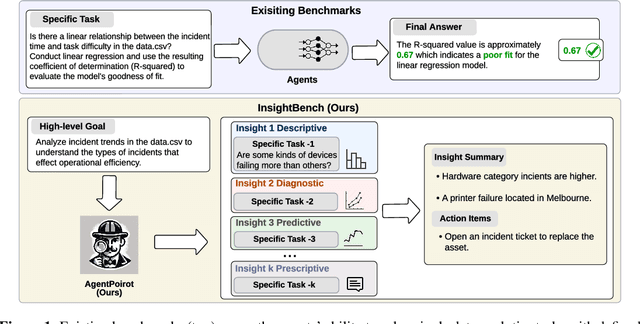
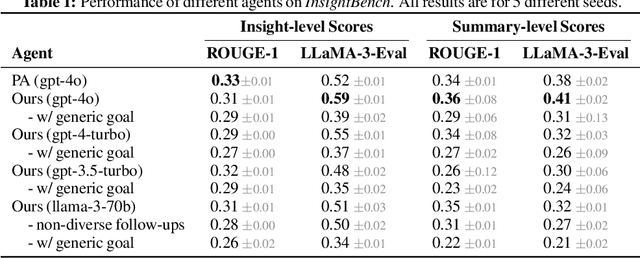

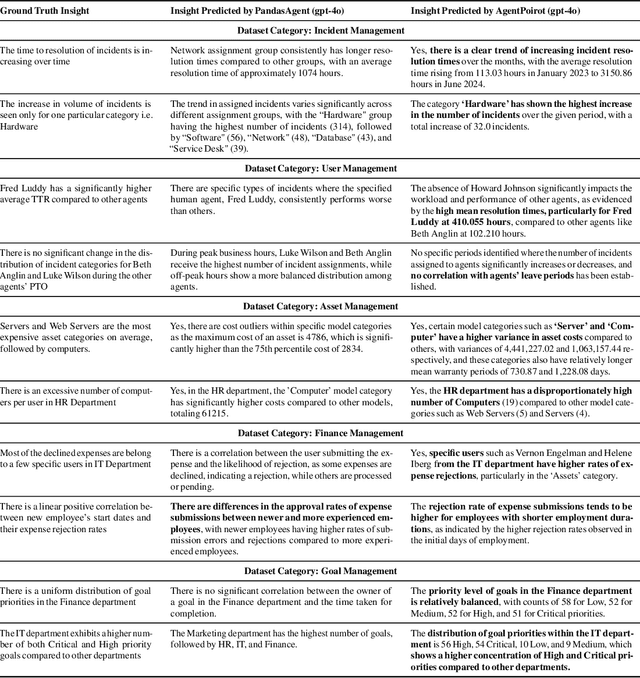
Abstract:Data analytics is essential for extracting valuable insights from data that can assist organizations in making effective decisions. We introduce InsightBench, a benchmark dataset with three key features. First, it consists of 31 datasets representing diverse business use cases such as finance and incident management, each accompanied by a carefully curated set of insights planted in the datasets. Second, unlike existing benchmarks focusing on answering single queries, InsightBench evaluates agents based on their ability to perform end-to-end data analytics, including formulating questions, interpreting answers, and generating a summary of insights and actionable steps. Third, we conducted comprehensive quality assurance to ensure that each dataset in the benchmark had clear goals and included relevant and meaningful questions and analysis. Furthermore, we implement a two-way evaluation mechanism using LLaMA-3-Eval as an effective, open-source evaluator method to assess agents' ability to extract insights. We also propose AgentPoirot, our baseline data analysis agent capable of performing end-to-end data analytics. Our evaluation on InsightBench shows that AgentPoirot outperforms existing approaches (such as Pandas Agent) that focus on resolving single queries. We also compare the performance of open- and closed-source LLMs and various evaluation strategies. Overall, this benchmark serves as a testbed to motivate further development in comprehensive data analytics and can be accessed here: https://github.com/ServiceNow/insight-bench.
RepLiQA: A Question-Answering Dataset for Benchmarking LLMs on Unseen Reference Content
Jun 17, 2024Abstract:Large Language Models (LLMs) are trained on vast amounts of data, most of which is automatically scraped from the internet. This data includes encyclopedic documents that harbor a vast amount of general knowledge (e.g., Wikipedia) but also potentially overlap with benchmark datasets used for evaluating LLMs. Consequently, evaluating models on test splits that might have leaked into the training set is prone to misleading conclusions. To foster sound evaluation of language models, we introduce a new test dataset named RepLiQA, suited for question-answering and topic retrieval tasks. RepLiQA is a collection of five splits of test sets, four of which have not been released to the internet or exposed to LLM APIs prior to this publication. Each sample in RepLiQA comprises (1) a reference document crafted by a human annotator and depicting an imaginary scenario (e.g., a news article) absent from the internet; (2) a question about the document's topic; (3) a ground-truth answer derived directly from the information in the document; and (4) the paragraph extracted from the reference document containing the answer. As such, accurate answers can only be generated if a model can find relevant content within the provided document. We run a large-scale benchmark comprising several state-of-the-art LLMs to uncover differences in performance across models of various types and sizes in a context-conditional language modeling setting. Released splits of RepLiQA can be found here: https://huggingface.co/datasets/ServiceNow/repliqa.
VCR: Visual Caption Restoration
Jun 10, 2024



Abstract:We introduce Visual Caption Restoration (VCR), a novel vision-language task that challenges models to accurately restore partially obscured texts using pixel-level hints within images. This task stems from the observation that text embedded in images is intrinsically different from common visual elements and natural language due to the need to align the modalities of vision, text, and text embedded in images. While numerous works have integrated text embedded in images into visual question-answering tasks, approaches to these tasks generally rely on optical character recognition or masked language modeling, thus reducing the task to mainly text-based processing. However, text-based processing becomes ineffective in VCR as accurate text restoration depends on the combined information from provided images, context, and subtle cues from the tiny exposed areas of masked texts. We develop a pipeline to generate synthetic images for the VCR task using image-caption pairs, with adjustable caption visibility to control the task difficulty. With this pipeline, we construct a dataset for VCR called VCR-Wiki using images with captions from Wikipedia, comprising 2.11M English and 346K Chinese entities in both easy and hard split variants. Our results reveal that current vision language models significantly lag behind human performance in the VCR task, and merely fine-tuning the models on our dataset does not lead to notable improvements. We release VCR-Wiki and the data construction code to facilitate future research.
XC-Cache: Cross-Attending to Cached Context for Efficient LLM Inference
Apr 23, 2024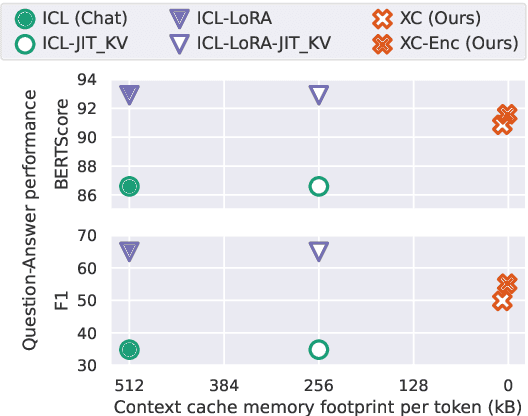
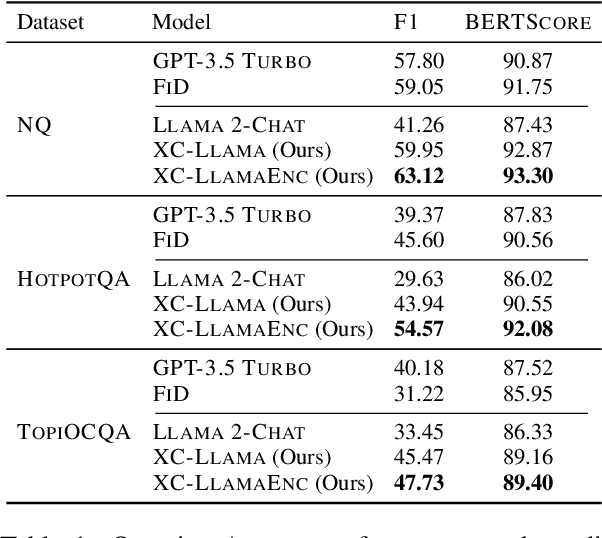
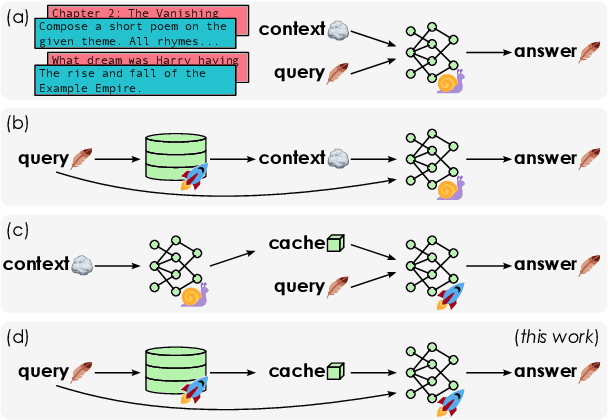
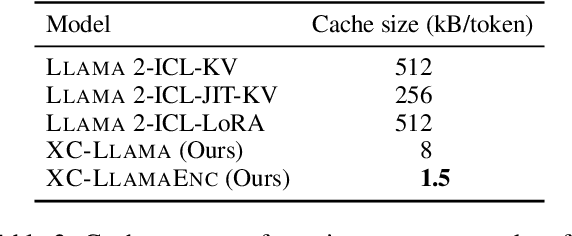
Abstract:In-context learning (ICL) approaches typically leverage prompting to condition decoder-only language model generation on reference information. Just-in-time processing of a context is inefficient due to the quadratic cost of self-attention operations, and caching is desirable. However, caching transformer states can easily require almost as much space as the model parameters. When the right context isn't known in advance, caching ICL can be challenging. This work addresses these limitations by introducing models that, inspired by the encoder-decoder architecture, use cross-attention to condition generation on reference text without the prompt. More precisely, we leverage pre-trained decoder-only models and only train a small number of added layers. We use Question-Answering (QA) as a testbed to evaluate the ability of our models to perform conditional generation and observe that they outperform ICL, are comparable to fine-tuned prompted LLMs, and drastically reduce the space footprint relative to standard KV caching by two orders of magnitude.
 Add to Chrome
Add to Chrome Add to Firefox
Add to Firefox Add to Edge
Add to Edge